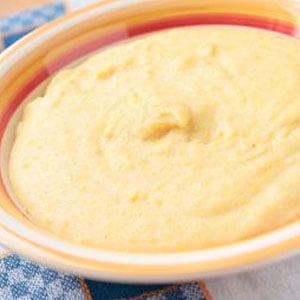
Does mieliepap (maize meal porridge) have a high or a low glycaemic index? The answer is not really straightforward because mieliepap can have either a high GI, an intermediate or a low GI depending on the temperature at which it is eaten. Now this is quite a difficult concept for most people to understand, but there are a number of starches which have a lower GI when they are eaten cold, rather than hot. Potato salad is another example of how the GI of a starch can be lowered by reducing its temperature.
Staple foods with a high GI
Maize meal porridge or mieliepap is probably the most important staple food eaten in Southern Africa. Bread baked with wheat flour is the second most popular staple food in South Africa. It is therefore, of concern that hot mieliepap and brown, wholewheat and white breads all have a high GI-value (see Table below).
I have often wondered if the fact that the two most commonly eaten staple foods in this country have a high GI may be contributing to increased insulin levels, insulin resistance and ultimately to type 2 diabetes and metabolic syndrome, which are fuelling the obesity epidemic in South Africa.
In addition, I was perplexed to read a diabetic diet brochure distributed by a very competent medical doctor, which listed pap (maize meal porridge) at every meal as the starch of choice. When I asked the good doctor why a high GI food was being recommended three times a day for diabetic patients, he said that he had adapted the brochure from one previously distributed by one of our major government hospitals. I was amazed.
I fully understand that maize meal or mieliepap is the staple food of a large number of people in this country, and that a very large proportion of black type 2 diabetics are not in a position to buy fancy low-GI cereals, but it would have helped if the brochure had at least mentioned that cooked, hot mieliepap has a high GI, but that the GI can be lowered by cooling the porridge down and eating it cold (low GI) or reheating it (intermediate GI).
Yes, the concept is complicated and it does involve some extra effort (cooking, cooling and in some cases reheating), but the ultimate benefits are worth explaining and could make a significant difference to the health of the nation.
Tips to lower the GI of mieliepap and wheat bread
The GI of mieliepap and wheat bread can be lowered by any one of the following:
- cook mieliepap, cool it down and eat it cold with low-fat milk or maas
- cook mieliepap, cool it down, reheat it and eat it hot with low-fat milk or maas
- add any of the following to mieliepap to lower the GI of the combination dish:
- low-fat milk, low-fat sour milk or low-fat maas or low-fat yoghurt , soya milk
- vegetable stews with or without a bit of lean meat
- cooked legumes such as dry beans, peas, lentils, soya
- add any of the following to white, brown or wholewheat bread to lower the GI of the combination dish:
- any one of the milk products listed above
- vegetables stews, lean meat, fish, eggs or cooked legumes
- peanut butter
Please note the emphasis on low-fat throughout for diabetics or anyone who needs or wants to lose weight. A low-fat diabetic diet can help patients lose weight (you “save” 37 kJ per gram of fat that you avoid) and can help prevent heart disease, which is often associated with diabetes and obesity.
So type 2 diabetics can still eat their mieliepap or maize meal porridge three times a day, but they will achieve much better control of their blood sugar levels, insulin levels, weight and health, if they cook their pap, cool it down and then eat it together with other low-GI foods. The same can be said for standard white, brown and wholewheat bread when combined with other low-GI foods.
The Glycaemic Load (GL) concept
The Table shown below is based on GI- and GL-values published in The South African Glycemic Index & Load Guide by Gabi Steenkamp and Liesbet Delport, two dietitians who have dedicated their lives to making the concept of the GI and GL accessible to the public.
a) The GI:
To briefly recap, the GI of a food is an indication of the effect that a standard portion of a given food will have on blood glucose values compared to the effect of a standard portion of glucose. The rise in blood sugar caused by the standard portion of glucose is classed as 100 and all other effects on blood sugar that foods have, are compared to glucose.
Although most patients want to know to the third decimal place what the GI of a given food is, the GI-values are generally divided into three broad categories:
- The Low-GI category for foods with a GI between 0 and 55
- The Intermediate-GI category for foods with a GI between 56 to 69
- The High-GI category for foods with a GI between 70 and above (please note that some high-GI foods can even have a GI above that of glucose; for example maltodextrin has GI of 120).
(Steenkamp & Delport, 2007)
b) The GL:
The Glycaemic Load or GL is a relatively new concept that was developed by scientists at Harvard University to help patients understand that even high-GI foods can be included in their diets and that there are no "good" or "bad" foods. The GL also helps to counter the idea that just because a food has a low GI, you can eat unrestricted quantities of such a food and not gain weight.
The GL represents not only the quality of the carbohydrate that has been eaten, but also its quantity. The GL is calculated by multiplying the GI of a given food by the quantity of carbohydrate in a standard portion of that food and dividing the answer by 100 (Steenkamp & Delport, 2007).
Steenkamp and Delport (2007), cite the following example: The GI of a medium apple is 38 = Low-GI and its GL = 7, so eating one medium apple is not going to have a dramatic effect on your blood sugar.
But if you eat a large quantity (let’s say 500g) of dried apple which has a GI of 29 = Low GI and a low GL of 3 per 20g portion, then 3 x 500/20 = 75 GL which will have a most pronounced effect on your blood sugar and insulin values.
The importance of the GL is, therefore, to alert us to the fact that both the glycaemic index or GI and the glycaemic load or GL are important, as are portion sizes.
GI- and GL-Values of South African Staple Foods per Standard Portion (Low-GI cereal and bread are included for comparative purposes)
Name of Food | GI | Portion size | Weight (g) | Carb Content | GL |
Maize meal/Mieliepap/Pap/Phutu | |||||
Maize meal/ Mielie-pap/ Pap/ Phutu, crumbly, HOT | 74 | 1 cup | 140 | 46.9 | 35 |
Maize meal/ Mielie-pap/ Pap/ Phutu, crumbly, COOLED | 50 | 1 cup | 140 | 46.9 | 23 |
Maize meal/ Mielie-pap/ Pap/ phutu, stiff, HOT | 74 | 1 cup | 250 | 49.0 | 36 |
Maize meal/ Mielie-pap/ Pap/ phutu, stiff, COOLED | 50 | 1 cup | 250 | 49.0 | 25 |
Maize meal/ Mielie-pap/ Pap/soft, no sugar,HOT | 83 | 1 cup | 250 | 28.5 | 24 |
Low-GI Breakfast Cereal, All-Bran, Hi-Fibre, Kellogg | 43 | 1 cup | 90 | 40.5 | 17 |
Wheat Breads | |||||
Brown bread, Sasko | 81 | 1 slice | 44 | 18.6 | 15 |
White bread, Sasko | 72 | 1 slice | 44 | 20.3 | 15 |
Wholewheat bread, homemade | 70 | 1 slice | 50 | 22.1 | 15 |
Low-GI Bread, Brown Low-GI, Blue Ribbon | 48 | 1 slice | 44 | 22.0 | 11 |
(Adapted from: Steenkamp G & Delport L (2007). The SA Glycemic Index & Load Guide)
Diabetic patients and people who want to lose weight can, therefore, use the high-GI staple foods of South Africa, namely mieliepap and standard white, brown or wholewheat bread, successfully provided they either cook and cool/reheat the mieliepap and combine the pap and the breads with other foods like maas, vegetables and legumes to lower the GI.
- (Dr IV van Heerden, DietDoc, February 2013)
(References: Steenkamp G & Delport L (2007). The SA Glycemic Index & Load Guide. GI Foundation of SA.)
(Photo of mieliepap/maize meal porridge from Shutterstock)
Any questions? Ask DietDoc




 Publications
Publications
 Partners
Partners














